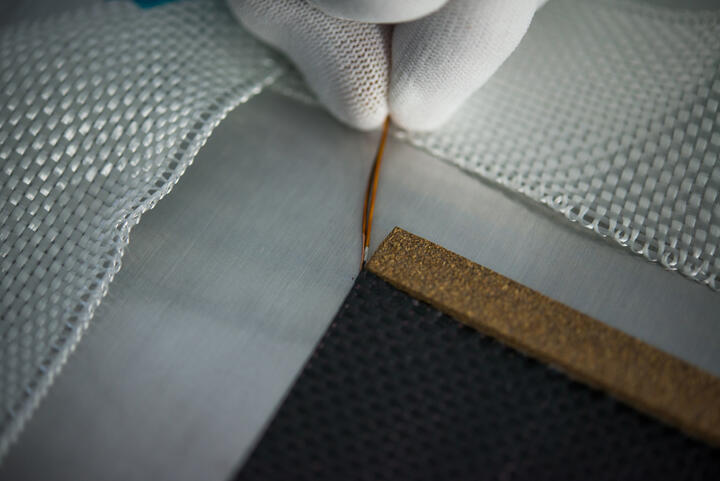Wireless sensors for lifelong monitoring of aircrafts
08 December 2022Wireless sensors as thin as human hair will be integrated into composite materials and embedded in aerospace components to monitor the condition of parts from manufacture to recycling with the aim of extending their life span, improving quality and reducing cost.
The University of Sheffield Advanced Manufacturing Research Centre (AMRC) is part of the INFINITE consortium, which has been launched to tackle some of the biggest challenges facing the European aeronautics industry: control of aerostructure manufacturing processes and operating conditions, and bringing down components’ cost.
Engineers from the AMRC’s composites team are supporting the consortium, which is funded by Horizon Europe under grant agreement No 101056884 and led by the Spanish research centre IDEKO, in developing a technology that will see wireless sensors incorporated into materials at the early stages of aeronautical structure manufacture. This will make it possible to track the entire life cycle of aeronautical structures, from on-site supervision of their manufacture and optimisation of maintenance work to thorough repair and service review through structural health monitoring (SHM) and recycling of parts at their end of life (EoL).
The package of works by the AMRC has been funded by Innovate UK. Composites research engineer, Fatma Omrani, is leading the AMRC’s involvement in the initiative for next-generation digital aircraft transformation in design, manufacturing, integration and maintenance.
Fatma said INFINITE will be a game changer for the aviation industry.
“Being able to integrate highly-specific sensors into composite aerospace structures so early in the manufacturing process, and monitor the full life of a component, will represent significant progress in what we call manufacturing health monitoring (MHM) and structural health monitoring (SHM),” she said.
“The early integration of these sensors and their wireless capability is a unique feature that is not currently available within existing solutions. It will provide means to manufacture higher quality components, as well as predict defects and damage more accurately. Imagine being able to tell if a part in the aircraft is safe without having to unnecessarily replace it as a precautionary measure?
“This will be a game changer. It will increase aircraft safety and component longevity, and reduce costs with predictive targeted maintenance, which will give a competitive advantage to European and UK aircraft industries.
“The composites team at the AMRC will combine its knowledge and expertise in structural health monitoring, dry fibre manufacturing and preforming, composite manufacturing and repair to support the project. The impacts of this project are substantial on the manufacturing of multifunctional and intelligent aircraft structures and will reinforce the AMRC’s leadership in these critical sectors.”
The sensors are based on magnetic materials and amorphous ferromagnetic microwires capable of reacting to electromagnetic radiation and will yield valuable information on the condition of the part at any time. These will be incorporated together with the dry carbon fibre, so they are embedded in the composite and their status monitored with a portable system to analyse the forces and temperatures to which the part is subjected and its condition.
Peio Olaskoaga, the technical coordinator of the INFINITE project, said: "The incorporation of these sensors at the very early stages of the life cycle will allow traceability of all subsequent stages of each component, and monitor their status with a non-invasive system to optimise their performance.
The INFINITE consortium believes this advanced monitoring has great potential for the European aeronautics industry; impacting the cost reduction and reliability of components, providing a competitive advantage to key players in the sector in Europe such as equipment manufacturers (OEMs), component manufacturers and maintenance and repair operators (MROs).
To ensure INFINITE is meeting the needs of the industry, an advisory panel has been established consisting of experts from major players in the European aeronautical landscape.


